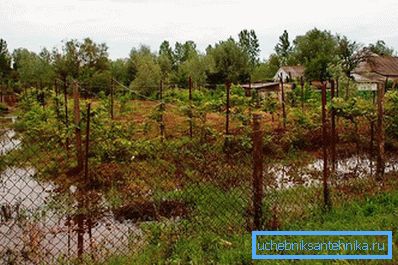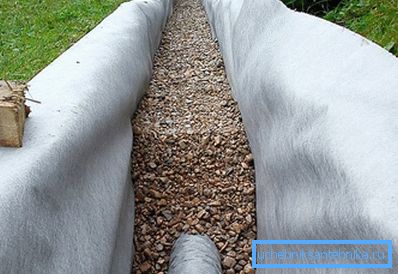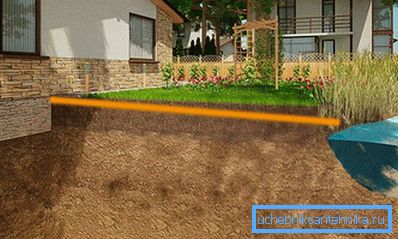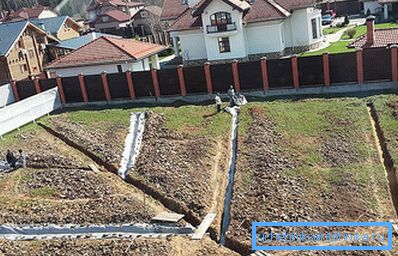Drainage area on clay soils themselves
Not all soils in suburban areas are well pass water. This is especially true for clay soils. Because of this, plants do not feel well and do not develop properly. To resolve this issue, you need a drainage area. Before you do the drainage of the area on clay soils with your own hands, we recommend reading this article.
Features of the clay area

The clay area is usually characterized by an excess of moisture. The presence of excess water leads to the fact that the roots of the plants do not receive the necessary amount of air. As a result, the process of oxygen starvation occurs, the plants cease to develop normally and eventually die. This is especially true of grassy lawns, suffering not only from an excess of moisture, but also because of the dense turf, which does not loosen or plow. Therefore, a dense top layer also prevents the full saturation of vegetation with air.
Tip! Depending on preferences, they create a lawn or plant different crops. To realize the plans conceived on clay soils, you first need to arrange a drainage system. Thanks to her, the site can be used immediately after the end of the winter season and the disappearance of snow cover.
If the suburban area does not differ in large size, the design does not necessarily perform the calculation. The main thing is to consider the basic parameters of the drainage system. All data that relate to drains can be counted among them - this is the slope, the depth of occurrence, the location of the plan, the distance between the rows, as well as the device of the manholes and the part. The suburban area is not always flat, so if there is a small slope of the earth's surface, it must be used.
The use of features of the relief area

If we compare the flat and sloping areas, it should be noted that working with the latter is much easier. In addition, in this case, in the construction of the drainage system, labor costs are significantly reduced. The main thing is to make the open drain well with the closed one.
Open or surface drainage is created using open top ditches. It will be effective for organizing the outflow of water in the warm period of the year, when heavy rainfall periodically falls, as a result of which the groundwater level rises. Such drainage is also needed in the winter. In many latitudes during the winter period there are frequent thaws, during which the frozen ground does not absorb moisture, and water removal from the surface of the earth is already necessary.
At the device of open drainage in such cases a special tile is used, which, thanks to a small slope, removes water. Through such a system, water from the roof of buildings and asphalt areas enters the closed drainage system, which is the main one.

Closed drainage functions as follows: water discharged from the surface moves through underground communications in the form of pipes.
Tip! Since clay soil is heavy and dense, to improve its drainage properties, the soil must be well loosened. When laying drains need to bypass the places that are intended for the passage of vehicles.
Device closed drainage system

- Before starting the arrangement of the closed drainage system, it is necessary to decide on the choice of water intake. In its role may be a natural pond or artificial ditch, located near the road. If there are none, the problem can be solved in several ways, which will need to be implemented independently. There are several options for organizing the outflow of water. You can create an artificial pond in the form of a pond. It's okay if it will resemble a small wetland. You can also dig a deep ditch beyond the borders of your plot, and this event should be coordinated with the neighbors in an amicable way. Finally, you can dig up small wells with vertical walls, from which, if necessary, periodically pump water out of the pumps. For units, you can provide automatic pumping mode.
- The trenches are digging along the contour of the plot, the depth and width of which should not exceed 1.2 and 0.4 m respectively. Pipes for collecting water are placed in these canals, which can be called main, and they should reach the water intake. For laying through trunk canals, pipes of O110 mm are best suited. The depth of the main pipelines with respect to the collecting branches of the drainage should be slightly greater. According to the regulatory and technical literature, drainage pipelines should be placed no closer than 0.5 m from the fence, and 1 m from the blind area of the building.
- Water is first collected in drainage trenches, after which it enters the main canals. At the site it is necessary to create a network of trenches with a depth and width of 1.2 and 0.35 m, respectively, in which it is necessary to put collecting drainage pipe branches. When creating a trench network, small channels are arranged under an incline of 5 cm per 1 m. With such a drainage device, the system will function normally. Smaller slope is not welcome, as the rate of flow of water will decrease, which will lead to stagnation in a particular area. In the clay area, the drains from each other should be at a distance of approximately 10 m.

- After a trench network is formed at the site, it should be left open and checked for operability. For testing, the best option is a heavy rainfall. If you are not lucky with the weather, you need to put water in the trench into the trenches, at the same time to monitor the flow rate and the presence of stagnation in some areas. If problems arise, you will need to work on adjusting one parameter or another - to increase the flow rate, you need to change the pipes for products of larger diameter or increase the slope. Another option is possible - to make the drainage network more dense.
- If the tests are successful, the drainage pipes close. This is done with the help of geotextiles, through which water is well seeping, but not part of the earth. Instead of geotextiles, special volumetric filters can be used, which have shown themselves well in the drainage of heavy clay soils. They do not allow pipes to be silted and are made from organic materials of porous structure. These include peat or coconut fibers and rye straw.
- Pipes are laid with fine-tuning to the main channels. The most practical for drainage plastic pipes O 63 mm with a corrugated surface.
- The connection of perforated pipes is carried out using tees or crosses.

- Open tube ends are also wrapped in geotextiles, which are fixed with wire.
- Then the pipes are filled with material through which water is well seeping. This is mainly rubble and sand. The layer of backfill at the top and side must be at least 0.15 m.
- The resulting “puff pie” is wrapped on top of the edges of the geotextile and covered with sand.
By making open and closed drainage of clay soils, you can completely get rid of excess moisture in a suburban area.
Video
This video will tell how to drain the soil near the house and in the garden: